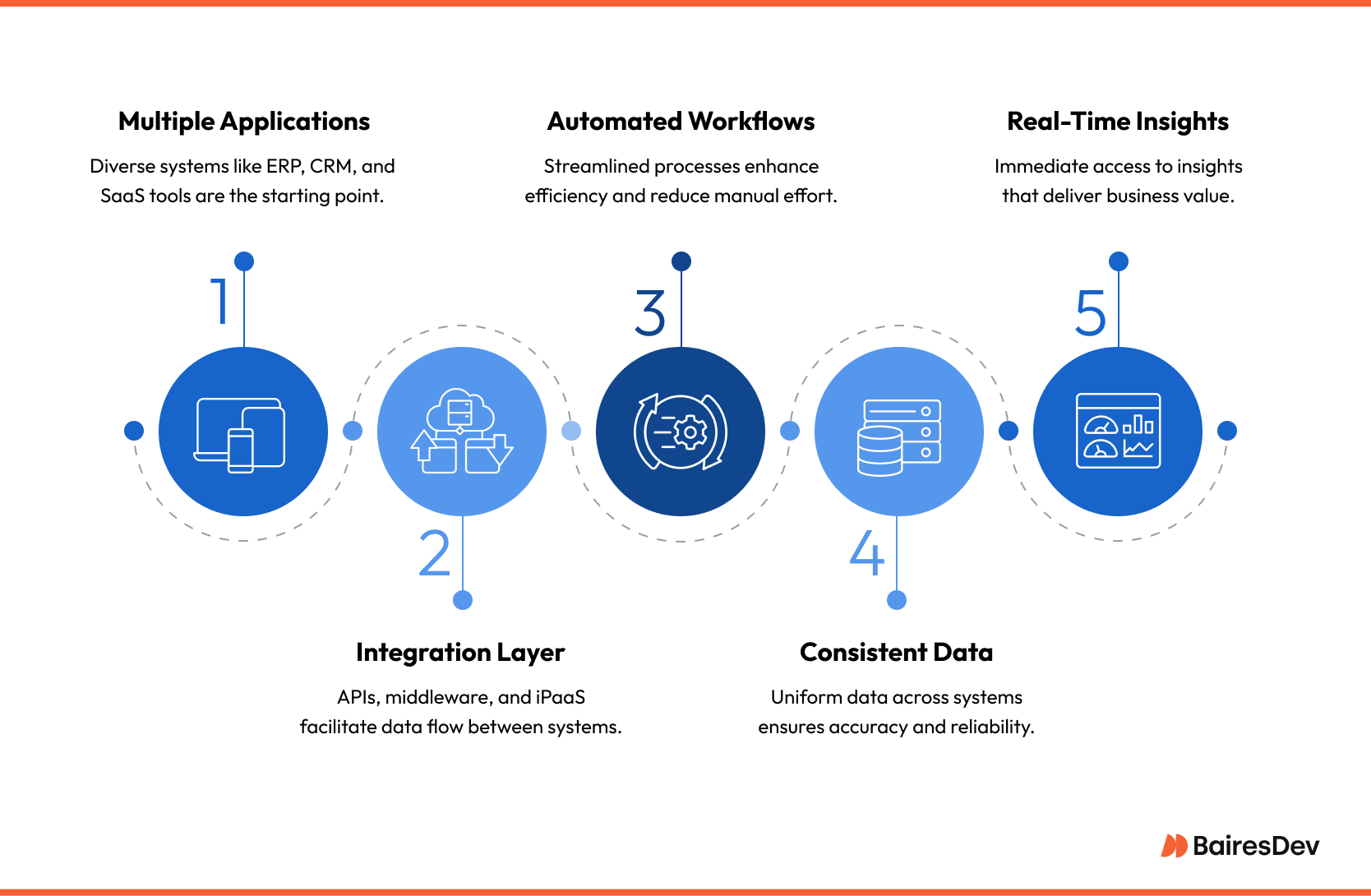Ask any CTO what slows a digital initiative and you’ll hear a familiar refrain: “Our systems don’t speak the same language.” Over the years we’ve stacked CRM, ERP, analytics, billing, and a dozen niche SaaS tools on top of one another. Each solves a real problem. Together, they create an invisible tax on every business process.
That tax shows up in odd places. A sales VP chases three versions of last quarter’s revenue because finance, customer success, and the e-commerce site all track orders differently. Meanwhile, supply-chain managers wait an extra day for inventory numbers that already sit in a warehouse system no one thought to connect. These delays aren’t the fault of any single application. They’re the consequence of treating software like isolated islands instead of parts of one operating model.

Enter application integration. Done well, it’s less a technology stack than a management discipline: decide which data matters, define how it moves, and automate that motion so people never have to re-key the same information twice. The tools vary: enterprise service bus, iPaaS, event streaming, API gateways, but the outcome is the same. Real-time data integration that collapses decision cycles and wipes out manual work.
Leaders usually notice three benefits first:
- Efficiency that sticks. Automated hand-offs cut hours, sometimes days, out of routine workflows. Teams feel it in their calendar before finance sees it in the P&L.
- One version of the truth. When an order, invoice, or shipment status updates in one application, every other system reflects that change immediately. Arguments over “whose spreadsheet is right” disappear.
- Headroom for innovation. Freed from constant data wrangling, product teams spend time on net-new features, often by plugging partner services or web-based APIs straight into the existing flow.
Naturally, it’s not a free lunch. Legacy on-premises applications guard data in proprietary formats. Cloud services shift APIs without warning. Security teams (rightly) scan every new endpoint for risk. Even low-code integration platforms demand thoughtful architecture, clear ownership, and budget for ongoing governance. Skip those steps and the initial win turns into yet another brittle point-to-point connection.
So the question isn’t whether to integrate.It’s how to approach it without adding tomorrow’s technical debt. Start by mapping business processes end to end, not system by system. Identify the few data objects that span departments (orders, customers, inventory), then choose integration components such as event queues, RESTful APIs, and an enterprise service bus that keep those objects consistent. Finally, measure success in business terms: faster close, shorter order-to-cash, higher NPS.
Get those pieces right and the tech stack feels lighter overnight. More important, leadership gains a trustworthy, up-to-date view of the company. This is critical information for the next round of strategy decisions.
Why Enterprise Application Integration Feels Complicated and What to Do About It
No two business applications look alike. One comes from a long-standing ERP vendor still fond of proprietary XML payloads; another is a sleek SaaS analytics tool that speaks only REST and JSON. The minute you ask them to cooperate, three friction points emerge: data compatibility, security, and long-term maintainability.
Data compatibility. Formats and schemas rarely line up cleanly. Translating between them demands middleware that can map, transform, and validate data without introducing latency. Dozens of mappings later, the integration surface turns into its own product that must be versioned and governed.
Security. Each new connection expands the attack surface. Transport encryption and token-based access are table stakes, yet leadership also needs clear ownership: Who rotates the keys? Who reviews API changes? Without answers, integration becomes a risk accelerator instead of a process enabler.
Maintainability. Integration work that lives only in custom code ages poorly. Scalable solutions rely on reusable integration components to keep developer productivity intact as new projects appear, e.g., shared data contracts, standardized event topics, and a common monitoring layer.
Choosing the Right Technology for the Job
Selecting the right integration tools and techniques is critical for ensuring that data flows smoothly across systems.
- APIs remain the primary contract for machine-to-machine communication. Governed properly, they let teams expose capabilities without revealing internal complexity.
- Middleware and enterprise service buses (ESBs) add translation, routing, and policy control for heterogeneous environments where point-to-point links would spiral out of control.
- Event webhooks deliver lightweight, near-real-time updates that keep loosely coupled systems in sync, which is ideal for customer-facing workflows that cannot tolerate polling delays.
- Integration platforms (iPaaS) wrap these patterns in drag-and-drop tooling, pre-built connectors, and centralized monitoring, shortening time-to-value and reducing the need for one-off scripts.
Common Integration Models and Their Trade-offs
Understanding when point-to-point integrations make sense, and when a service bus becomes a liability, is essential for designing a good architecture.
- Point-to-point connections are quick to spin up but multiply exponentially as more systems join the mix. They fit tactical needs, not enterprise scale.
- Hub-and-spoke (classic enterprise application integration) centralizes data exchange through a single broker. Governance improves, yet the hub can become a choke point if not architected for high throughput.
- Enterprise service bus builds on the hub concept with richer mediation, policy enforcement, and message orchestration. It’s well suited to large organizations running a blend of cloud and on-premises applications.
The right model depends on business priorities: speed versus control, startup cost versus future agility. What remains constant is the goal: enable communication across multiple applications, keep data consistent, and automate business processes so leadership gets timely, reliable intelligence without drowning in integration debt.
Techniques That Break Down Data Silos
Growing enterprises rarely suffer from a lack of connectivity options; the challenge is picking the technique that scales without turning tomorrow’s architecture into a maze of brittle links.

Point-to-Point Links: Good for a Sprint, Dangerous for a Marathon
Directly wiring two applications can feel refreshingly quick. An order entry system shoves JSON to the ERP; the ERP replies with XML. It works until a third, fourth, and fifth system appear. Connections multiply, mapping rules diverge, and soon every release triggers regression tests across dozens of bespoke scripts. Point-to-point remains a tactical fix, not an enterprise strategy.
Data Integration for After-the-Fact Insight
Some firms choose to let operational systems run independently and merge the data later in a warehouse or lake. That approach keeps production traffic light and simplifies analytics, but it cannot drive real-time workflows. If executives need an up-to-date view of inventory or customer data inside an active business process, post-process integration falls short.
Middleware and the Enterprise Service Bus
Placing a translation layer, whether classic ESB, message-oriented middleware, or an API-led gateway, gives IT one spot to enforce business rules, manage security tokens, and transform data formats. The trade-off: a learning curve and the need for disciplined governance. Done well, middleware becomes the stable backbone that lets new SaaS applications or on-premises systems plug in without rewriting core code.
Service-Oriented and Event-Driven Architectures
Moving from monolithic integrations to loosely coupled services or event streams adds resilience and agility. Each service exposes a clear contract; events broadcast state changes the instant they occur. Business functions subscribe only to what they need, reducing unnecessary chatter and paving the way for true process automation across departments.
iPaaS for Speed and Self-Service
Integration-platform-as-a-service tools wrap common patterns, such as API management, data mapping, protocol mediation, inside low-code designers. Business units can create integrations quickly, yet central IT retains visibility, security controls, and performance dashboards. For organizations juggling cloud applications, legacy ERP systems, and trading-partner portals, iPaaS often delivers the fastest path to seamless integration without a mountain of custom code.
Turning Challenges into Engineering Discipline
Before committing to any technique, leadership should press teams on four questions:
- Business value: Which workflow or customer journey improves if this integration goes live?
- Timing: Is the benefit urgent, or can it wait until related road-map items converge?
- Capacity: Do we have the skills to own this long term?
- Compatibility: Will the new link respect existing governance, or does it bypass shared conventions?
Clear answers keep scope in check and surface hidden costs early.
Additional guardrails:
- Deep system knowledge. Map data formats, versioning policies, and authentication schemes before a single line of glue code appears.
- Reusable components. Standardize data contracts and logging so the next project inherits proven building blocks.
- Continuous testing. Treat every interface change as a deployment event; simulate traffic in lower environments to protect production uptime.
Custom Fit Beats Off-the-Shelf Hype
Drag-and-drop designers are handy, but they cannot guess your business rules. A logistics firm, for example, gains little from a generic WMS-to-TMS connector if the real advantage lies in predictive slotting and real-time carrier re-rate logic.
Integration components must bend to those nuances: custom event topics, extended data fields, and orchestration steps that mirror the way freight actually moves.
Selecting an Integration Platform That Won’t Age Out
When evaluating application-integration solutions, senior leaders should look beyond feature checklists:
- End-to-End Orchestration. Can the platform transform, enrich, and route data without external scripts?
- Lifecycle Governance. Does it manage API versions, credentials, and audit trails from prototype through sunset?
- Analytics and Observability. Are latency, throughput, and error patterns surfaced in language business owners understand?
- Elastic Scale. Will the engine keep pace as transaction volumes spike or new cloud regions come online?
- Hybrid Reach. Can it enable communication between cloud services and on-premises applications with equal ease?
A platform that excels in these areas turns integration from a reactive chore into a strategic capability, one that underpins business agility, protects data consistency, and frees teams to focus on innovation rather than plumbing.
Lessons From the Field: Where Integration Projects Go Sideways and How to Pull Them Back
After dozens of enterprise rollouts, our architects keep encountering the same friction points in different integration processes:
- Non-standard or fast-evolving APIs. A vendor ships a minor version and suddenly an optional field is mandatory; downstream workflows stall until a hotfix ships.
- Shifting or ambiguous requirements. Integration flows often juggle three sets of expectations: internal stakeholders, external partners, and the platform vendor. Teams often discover that no single document matches reality.
- Sparse documentation. Even well-known SaaS products can leave critical edge-case behaviors undocumented, forcing engineers to reverse-engineer payloads under tight deadlines.
- Tangled code bases. When integration logic lives inside the main application, every deployment risks breaking both domains. Untangling them later costs far more than isolating them from day one.
- Limited test scaffolding. Many ERP and payment providers expose production-only endpoints, so teams must build sophisticated mocks or accept the risk of live-data testing.
- Incomplete observability. Without standardized logging and alerting, operations teams learn about failures from business users, not dashboards.
We’ve mitigated these issues by standardizing a few practices:
- Message-oriented middleware (MOM) for asynchronous workloads, improving resilience and smoothing traffic spikes.
- Dedicated integration repositories that separate transformation logic from product code, preserving developer productivity.
- Contract-first design and automated contract tests to catch breaking changes before they hit production.
- Centralized monitoring that surfaces latency, error rates, and business KPIs in the same dashboard.
When those disciplines are in place, adding a new SaaS application or partner feed becomes incremental, not a fire drill.
Complexity Is Inevitable but Disorder Isn’t
Integrations will always introduce moving parts: multiple data formats, evolving schemas, competing security models. The goal is not to wish that complexity away but to contain it with sound architecture:
- Microservices and event streams localize change, so a new product feature touches only the bounded context it needs.
- Reusable integration components let teams assemble workflows without reinventing the plumbing.
- Clear ownership models ensure every endpoint has a named custodian responsible for uptime, versioning, and security.
Enterprises that embrace this mindset gain a platform capable of supporting new business models, partner channels, and customer experiences at speed.
If your organization is staring down an integration backlog and isn’t sure where to start, a short architecture assessment often pays for itself. External specialists can pressure-test assumptions, surface hidden risks, and map a path from today’s tangle to tomorrow’s cohesive platform.
Bottom line: integration is hard, but the payoff is a unified enterprise that moves as one. With the right patterns, tools, and governance, complexity becomes a lever for competitive advantage rather than an anchor on innovation.
Frequently Asked Questions
What are the biggest business risks of poor application integration?
Disjointed systems create data silos, delay decisions, and increase operational costs. Finance may close the books on stale figures, supply-chain management teams might reorder stock they already own, and so on. Robust application integration reduces these risks by maintaining a single source of truth across enterprise applications.
How does effective integration improve cross-department decision-making?
When ERP systems, CRM platforms, and analytics tools share data in real time, leadership gains an up-to-date view of orders, inventory, and customer sentiment. That transparency shortens cycle times for everything from pricing changes to product launches because teams can act on the same, current information instead of manually reconciling spreadsheets.
What should we look for when evaluating an integration platform vendor?
Prioritize a solution that combines strong API management, native support for both cloud and on-premises applications, and clear governance features. Equally important are observability dashboards that translate integration performance into business language.
How does application integration support agile operations?
An API-led or event-driven architecture allows teams to add new services without rewriting the core stack. That flexibility keeps release cycles short and enables controlled experimentation—critical for agile product road maps where market feedback shapes the next sprint.
How do integration strategies differ for on-premises applications?
On-prem systems often rely on legacy protocols and fixed maintenance windows, while cloud applications evolve APIs rapidly and scale elastically. A hybrid approach keeps both worlds in sync without forcing either to conform to the other’s constraints.
Why is API management central to modern enterprise integration?
Well-governed APIs act as productized access points to business capabilities. They control rate limits, authentication, and schema versions, ensuring that partner teams and external developers can innovate without jeopardizing core services. Strong API management, backed by analytics, also highlights underused endpoints that may represent untapped business value.
How can integration solutions strengthen compliance and data governance?
Centralized transformation layers enforce data-handling rules, thus masking personal information, filtering sensitive fields, and logging access for audits. When those guardrails are baked into the integration framework, new projects inherit compliance by default rather than tacking it on later.






